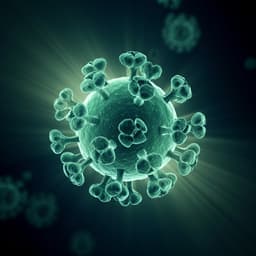
Medicine and Health
Model-based evaluation of school- and non-school-related measures to control the COVID-19 pandemic
G. Rozhnova, C. H. V. Dorp, et al.
This study reveals how school-based measures impact the transmission of COVID-19 in the Netherlands, emphasizing that the effectiveness of school closures heavily relies on the accompanying non-school measures. Conducted by Ganna Rozhnova, Christiaan H. van Dorp, Patricia Bruijning-Verhagen, Martin C. J. Bootsma, Janneke H. H. M. van de Wijgert, Marc J. M. Bonten, and Mirjam E. Kretzschmar, the findings suggest a nuanced approach to pandemic management is critical.
~3 min • Beginner • English
Introduction
In autumn 2020, the Netherlands and many other countries experienced a second wave of COVID-19. During the first wave, broad non-pharmaceutical interventions (NPIs) were implemented, including physical distancing, hygiene measures, self-quarantine when symptomatic, and closures of many public places and schools. After partial relaxation from May 2020, incidence rose again by late July, and measures were intensified step-wise from late August. Schools reopened after the summer break and remained open until mid-December with limited in-school measures. The effective reproduction number (Re) was about 1.3 in late August/early September and about 1.0 by mid-November, with a government target of 0.8. It was unclear to what extent open schools contributed to sustained transmission, since children appear less susceptible to SARS-CoV-2 than adults and susceptibility increases with age. This study aims to quantify the role of school-based contacts in SARS-CoV-2 transmission and evaluate the relative impact of school- versus non-school-related measures at different stages of the Dutch epidemic, addressing whether keeping schools closed after summer 2020 could have prevented a second wave and whether closing schools in November 2020 could have brought Re below 1.
Literature Review
Evidence from influenza shows school closures can be effective in mitigating pandemics due to high contact rates among children, but SARS-CoV-2 differs as children appear less susceptible and their role in transmission is less clear. Prior modeling studies assessed NPIs and school measures, often assuming age-independent susceptibility or lacking formal fitting to epidemiological data. Observational studies and cross-country analyses produced mixed findings on the impact of school closures, complicated by concurrent implementation of multiple NPIs and heterogeneity in school measures. Some models suggested reopening schools without strong testing/tracing could trigger a second wave, and that secondary schools may contribute more to community transmission than primary schools. This study builds on and differs from prior work by using a Bayesian-fitted age-structured transmission model calibrated to Dutch hospital admissions and seroprevalence, incorporating age-dependent susceptibility and empirical contact matrices before and after lockdown.
Methodology
Design and data: The study uses a deterministic age-structured SEIR model fitted in a Bayesian framework to Dutch age-stratified hospital admissions (n=10,961; 27 Feb–30 Apr 2020) and cross-sectional age-stratified seroprevalence data (n=3,207; April/May 2020, PIENTER Corona). Demographic composition (July 2020) and age-stratified contact data for the Netherlands were used, including contact matrices from 2016/2017 (pre-pandemic), April 2020 (post-lockdown), and school-specific contact rates from POLYMOD.
Model structure: The population is stratified into 10 age groups: (0–5), (5–10), (10–20), [20–30), [30–40), [40–50), [50–60), [60–70), [70–80), and 80+. Compartments: Susceptible (S_k), Exposed (E_k), Infectious in m stages (I_kp, p=1..m), Hospitalized (H_k; cumulative admissions), and Recovered (R_k). Transmission is frequency-dependent with probability of transmission per contact ε; after March 2020, it is reduced to ε·ζ to capture general measures (e.g., masking, hygiene, self-isolation). Susceptibility is age-dependent via β_k relative to the 60+ group (reference = 1). Latent rate α; infectious period parameter γ; m=3 infectious stages (Erlang-distributed infectious period).
Contacts: General contact rate c_kl(t) transitions smoothly from pre-lockdown b_kl to post-lockdown a_kl via a logistic function f(t). To separate school and non-school contacts, pre-lockdown contacts b_kl are decomposed into school contacts s_kl^high and non-school contacts b_kl^as. Post-lockdown a_kl excludes school contacts. During relaxation, contacts evolve via c_kl(t) = [1−g(t)]a_kl + g(t)(b_kl^as − s_kl^high) + ω s_kl^high, where g(t) is logistic, and ω (0–1) scales retained school contacts (ω=1: full pre-pandemic school contacts; ω=0: schools closed). Reduced adherence during relaxation is represented by parameter ζ.
Initial conditions and importations: Start date t0=22 Feb 2020. An initial fraction θ in each age group is infected at t0, split between E_k and I_k.
Observation model and inference: Daily hospital admissions per age group are modeled with a Negative Binomial likelihood (over-dispersion r) proportional to prevalent infectious individuals; seroprevalence uses a Binomial likelihood based on predicted non-susceptible fraction at the median sampling time, adjusted for seroconversion delay. Bayesian inference via Hamiltonian Monte Carlo in Stan (4 chains; 1500 iterations each; 1000 warm-up; 2000 posterior samples). Priors: ε uniform(0,1); α, γ inverse-gamma informed by plausible latent and infectious periods; age-specific hospitalization rates with shared structure; age-dependent susceptibility informed by prior cohort evidence for age bands [0–20), [20–60), 60+ as reference.
Calibration for relaxation periods: Since second-wave hospitalization data were not used for fitting, ω, g, and ζ were calibrated so the model’s median Re matched RIVM estimates: ~1.3 (27 Aug–6 Sep 2020) and ~1.0 (7–13 Nov 2020). Re and R0 were computed with the next-generation matrix (NGM) method using posterior samples.
Scenarios: To quantify impacts, the model varied (i) reductions in non-school contacts while holding school contacts constant and (ii) reductions in school contacts while holding non-school contacts constant for August 2020 and November 2020. Additional analyses targeted reductions in school contacts by specific age groups: [0–5), [5–10), [10–20). Outcomes were expressed as changes in Re and percent reductions required to achieve Re<1.
Key Findings
- Model fit and epidemiological estimates:
- Excellent agreement between estimated and observed age-specific hospitalizations and seroprevalence. Hospitalizations increased strongly with age; estimated hospitalization probability rose from 0.09% (95% CrI 0.05–0.15%) in <20 years to 4.37% (95% CrI 2.80–8.82%) in >80 years.
- Median seroprevalence 2.7% overall in April/May 2020, highest in 20–40 years (~3.5%), lowest in 0–10 years (0.9%).
- Probability of transmission per contact estimated 0.07 (95% CrI 0.05–0.12) pre-lockdown; decreased by 48.84% (95% CrI 23.81–87.44%) after first lockdown.
- Relative susceptibility: compared to 60+, susceptibility was reduced by 23% (95% CrI 20–28%) in <20 years and by 61% (95% CrI 50–72%) in 20–60 years.
- R0 estimated at 2.71 (95% CrI 2.15–5.18) pre-measures (Feb 2020) and Re reduced to 0.62 (95% CrI 0.29–0.74) during full lockdown (Apr 2020).
- August 2020 scenarios (schools open; starting Re=1.31, 95% CrI 1.15–2.07):
- Reducing other (non-school) contacts by ~60% would bring Re≈1 if school contacts unchanged.
- Maximum non-school reduction (to April levels; 100%) would bring Re to 0.83 (95% CrI 0.75–1.10).
- Full school closure (100% reduction in school contacts) alone would reduce Re by about 10%, from 1.31 to 1.18 (95% CrI 1.04–1.83) if non-school contacts unchanged.
- Conclusion: Keeping schools closed after summer, without other measures, would not have prevented the second wave.
- November 2020 scenarios (partial lockdown; starting Re≈1.00, 95% CrI 0.94–1.33):
- Closing schools would reduce Re by 16%, from 1.00 to 0.84 (95% CrI 0.81–0.90), comparable to reducing non-school contacts to April levels (Re 0.83, 95% CrI 0.75–1.10) with schools open.
- Age-targeted school interventions (starting from Re≈1 in Nov 2020):
- Closing schools for 10–20-year-olds alone would reduce Re by about 8%.
- Closing schools for 5–10-year-olds would reduce Re by about 5%.
- Reducing contacts among 0–5-year-olds has negligible impact.
- Policy insight: The benefit of school-based measures grows when non-school-based measures have been maximized or are not feasible and Re remains near 1; secondary school measures yield the largest impact.
Discussion
The study addresses how school-based contacts contribute to SARS-CoV-2 transmission and how school versus non-school interventions affect control at different epidemic stages. The findings demonstrate that when Re is well above 1, reducing non-school contacts (primarily among adults) is more effective than closing schools. However, when prior measures have brought Re close to 1, additional reductions in school contacts can meaningfully push Re below 1, with the greatest impact achieved in secondary school age groups (10–20 years). These results align with age-dependent susceptibility and contact patterns—despite high contact rates among children, lower susceptibility in younger ages diminishes the proportional effect of primary school closures, whereas older adolescents/young adults contribute more to transmission. The model’s estimates of R0 and Re at key time points are consistent with independent national estimates, and the Bayesian fitting to hospitalizations and seroprevalence strengthens inference. For policymakers, the work clarifies trade-offs: if adherence or feasibility limits further reductions in non-school contacts, targeted school measures—especially in secondary schools—offer a viable path to reduce transmission. Conversely, if opportunities remain to reduce non-school contacts, school-based measures confer relatively modest additional benefit.
Conclusion
Using a Bayesian age-structured transmission model fitted to Dutch hospital and serological data, the study shows that the relative value of school-based measures depends on the extent to which non-school contacts can be reduced. With scope to further reduce non-school contacts, closing schools adds limited benefit. When Re remains near 1 and further non-school reductions are infeasible or undesirable, school-based measures—particularly in secondary schools—can substantially reduce transmission and bring Re below 1. The model framework and code are generalizable to other settings given appropriate data. Future work should refine age-specific susceptibility within child subgroups, quantify the impact of specific in-school mitigation measures, assess potential substitution of school contacts with out-of-school contacts, incorporate detailed categories of non-school contacts (e.g., work, leisure), and leverage additional hospitalization and serological data from later epidemic phases.
Limitations
Key limitations include: (1) Susceptibility within 0–20 years was modeled as a single category for estimation; increasing susceptibility with age may mean effects among older adolescents are somewhat underestimated. (2) School contact patterns during Aug–Nov 2020 were assumed similar to pre-pandemic; some reduction due to general measures may have already occurred, making estimated school-closure impacts an upper bound. (3) The model assumes reductions in school contacts are not replaced by non-school contacts with similar risk, which may overestimate benefits of school measures if substitution occurs. (4) Contact matrices during the pandemic did not allow separation of non-school contacts by setting (work, leisure, transport), limiting setting-specific policy inference. (5) Second-wave hospitalization data were not available for model fitting; relaxation period parameters were calibrated to national Re estimates. (6) Serology may underestimate prior infections, especially in mild/asymptomatic cases common in children, potentially underestimating children’s role in transmission. (7) No regional stratification; results reflect national-level averages.
Related Publications
Explore these studies to deepen your understanding of the subject.







